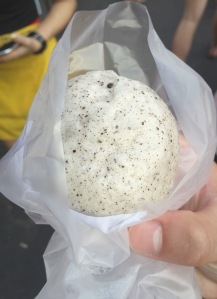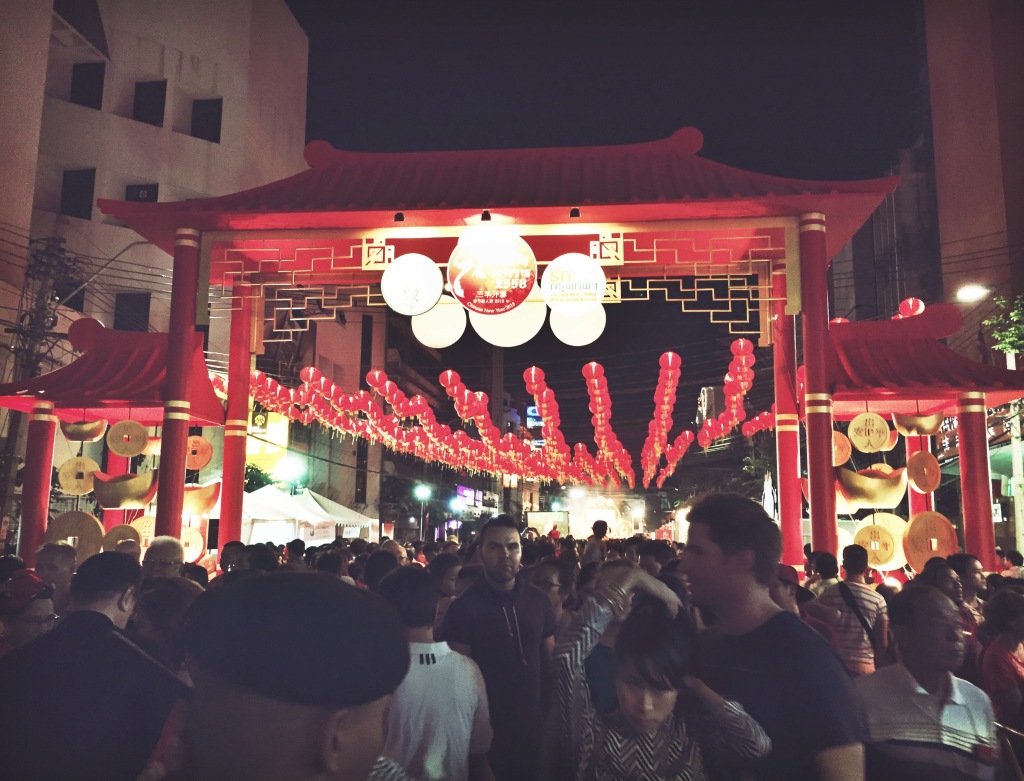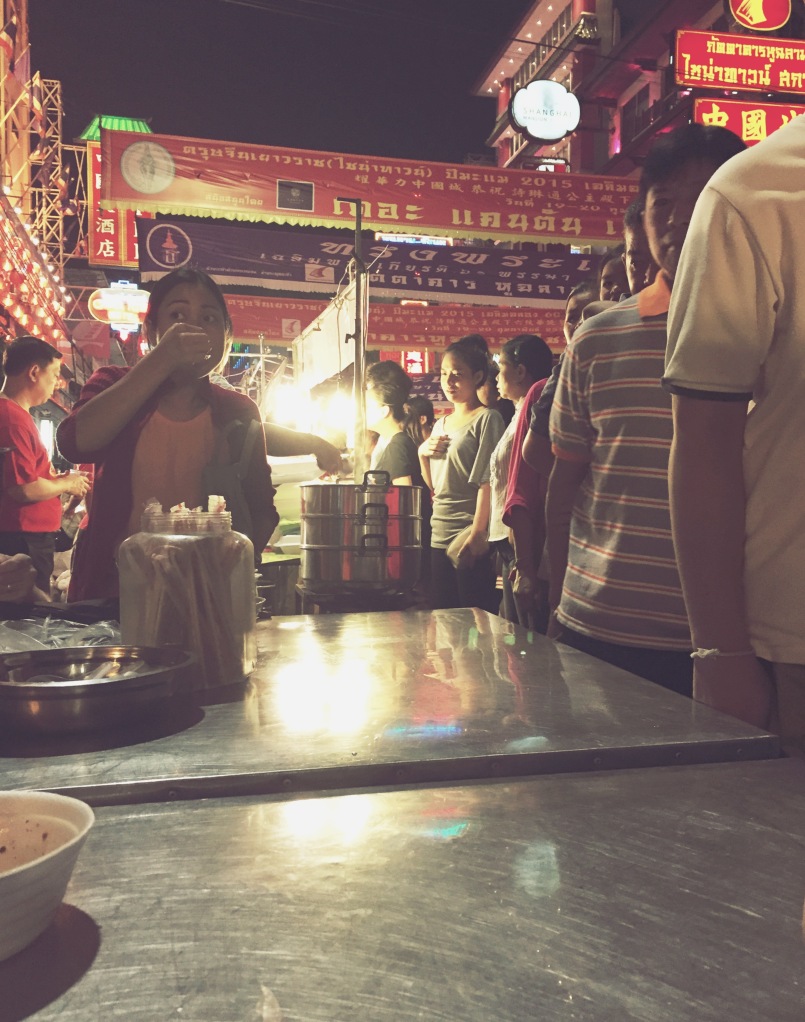Chinatowns in all the major cities have always been fascinating to me, and that’s probably because of my Chinese background. But as an English (and basic Cantonese) speaking Canadian, I have a different perceptions of the world than many of my friends. My upbringing has taught be a lot about how Chinese people interact with each other, how they cook and eat, the entertainment they enjoy, and how big of an influence the’ve had in the world. Every summer break off from elementary school I spent at my Grandma, Gneen Gneen’s house in North York. It was a bland time, but that is when I learned the most about my family’s heritage. I would eat dim sum, watch cheesy Chinese soap operas, and try to learn Cantonese. All of these experiences have translated to me feeling right at home in Thailand, and I was excited to discover I would spend this Chinese New Year in the largest Chinatown in Southeast Asia. I have been to some of the most notable Chinatowns, including: Toronto, Montreal, Boston, New York, and San Francisco, and they all have something special to offer to their communities. Often it is refuge for those who emigrated from China and Hong Kong, like my family did in Toronto, but it centralizes the Chinese peoples identity through culture and food. The latter of which I adore (more on that later).
Large amounts of Chinese businessmen and immigrants arrived in Thailand between the 13th and 15th century. They obviously needed land to reside in and participate in business, and the old capital of Ayutthaya Kingdom was chosen due to its encouragement of foreign trading. After the tragedies in Ayutthaya, the Chinese population was scattered. In the 1700’s, along with poor peasants from China, many of the scattered Chinese started to occupy the area that is now known as the Grand Palace in Rattanakosin. As King Rama I began developing the Grand Palace to recognize the new capital, the Chinese population were again displaced and ended up moving southeast of the palace to where they are today, Yaowarat Road. This deep history of Chinese in Thailand that has spanned over 800 years lends to some impacts on the demographics of Thailand. An eighth of Thai citizenship consists of complete Chinese ancestry, while astonishingly, just under half of Thai citizens are partly from Chinese ancestry. There is no doubt that the Chinese have had an immense impact on on the Thailand of today. Their ability to settle in areas of high cultural and economic value in history just attests to their ability to prosper on Yaowarat, and it is that intuition and pride that makes commerce to contagious as tourists pack the streets of this Chinatown. The glowing signage, wealth of restaurants and specialty shops, secret alleys, and sense of pride, are all what caught my attention and left me with the dying desire to share my experiences here on my blog.

The crowded streets are filled with lights, food vendors, and often, satisfied stomachs. Yee, N. (CC), 2015.
FOOD
For me food has always been my biggest motivator to explore new places, and it helps me appreciate different nationalities and cultures based on their own right. It’s just so fascinating how that ingredients that are special to geographical area can be a source of identity. For example, maple syrup will always be identified as Canadian, meanwhile rice would be identified as Asian – more specifically Thailand. When visiting Chinatown, I knew I would be in for a treat – I would be in for a taste of home like what Gneen Gneen always prepared. 
 Walking down the alleys proved to be one of the best places to see authentic products. One alley in particular was my favourite because of the beautifully steamed buns that were located about half way down the corridor. With a bunch of different fillings, the black sesame was heavenly. Unlike in a lot of places in Toronto where I’ve gotten buns, this shop loaded them with the right amount of fillings (lots). The charcoal black filling is a testament of the rich, well blended black sesame. In Chinese culture, it is used because of its health-promoting and anti-aging benefits, so you and I don’t have to feel guilty for eating one… two… three, or how ever many, right? These alleys are pretty easy to find, but the narrow way can be missed. I suggest looking for locals and tourists filing down passageways to find popular alleys and shops. Then prepare to be in awe of the quantity of Chinese goods. Here is a pinpoint of where my favourite bun place is:
Walking down the alleys proved to be one of the best places to see authentic products. One alley in particular was my favourite because of the beautifully steamed buns that were located about half way down the corridor. With a bunch of different fillings, the black sesame was heavenly. Unlike in a lot of places in Toronto where I’ve gotten buns, this shop loaded them with the right amount of fillings (lots). The charcoal black filling is a testament of the rich, well blended black sesame. In Chinese culture, it is used because of its health-promoting and anti-aging benefits, so you and I don’t have to feel guilty for eating one… two… three, or how ever many, right? These alleys are pretty easy to find, but the narrow way can be missed. I suggest looking for locals and tourists filing down passageways to find popular alleys and shops. Then prepare to be in awe of the quantity of Chinese goods. Here is a pinpoint of where my favourite bun place is:
Chinese food is a staple in my family, and since I am thousands of miles from them I had to look for a substitute. Your best bet is to really look around like I did, and buy lots of smaller things so you can get a taste of everything. There is no single best thing to try, but as a rule of thumb, if its popular than it wouldn’t hurt to give it a try. Where Chinatown always excels though, is in sweet treats. As a child, my dad always treated us to delicious Chinese snacks that were so different than most Western desserts. For example, the Dragon’s Beard candy is one that I saw a local make. It requires delicate hands that pull and stretch cotton candy-like floss until its thin, then she puts a peanut filling in.
Watching her make this was basically a cultural show, and a reminder of my childhood in Toronto. It was a real treat. For my main dish, I saw a lot of people pile in a little area that had stools and tables, and it seemed like a communal eating experience. I asked for one of whatever everyone was getting and it turned out to be a variety of meats in a noodle soup. It may not be for everyone, due to the inclusion of liver and other innards. It just is an example of how the Chinese really do use every part of an animal; and that sure is efficiency. For you Western-viewers, you may not understand my love for all these [weird] foods. It is not your usual take-out place, rather an authentic experience with delicacies. So my advice for Bangkok’s Chinatown is to keep an open mind when arriving with an empty belly.
CULTURE
The culture in Chinatown truly comes to life at night times. During the day the road on Yaowarat is still used by cars, but at night the road closes, the market is set up, and all the visitors come piling in. The lively glowing signs provide a certain warmth, while the restaurants all open up. It’s really hard to believe that above these shops are all homes to locals. It seems that the noise and bright lights are all a way of life not that this Chinatown has become a spectacle.
My second visit was on Chinese New Year where it is supposedly the biggest celebration in the world outside of China. I arrived in mid-day hoping to catch the parade, and festival vendors selling the best that China has to offer. The main road was closed off because of a visitation from officials and the Princess of Thailand. It was wild because there were thousands squeezing through the sidewalk space that was already littered with vendors and shops. It seemed like everyone was waiting for a parade but nothing was happening on the street, that is until we began to hear a vehicle coming closer. But no, it ended up just being the Pizza Company delivery guy somehow riding down the police controlled street. I guess someone really wanted their pizza. Soon after that hilarious let down the barricades were taken down and people rushed the streets. At dawn, the night market vendors begin setting up with clothing, technology, cheap toys, food, and other paraphernalia that you would never need, but make for great souvenirs. This whole time I wondered how all these people and all the sound affected the people living upstairs. But I guess that is just part of the lifestyle here, like a double-edged sword. You have the opportunity to prosper in a home-like environment that has a lot of business, at the cost having that business be a burden. But I still saw many Thais and Chinese enjoy their time taking in the Chinese festivities. Several times I ended up being chased by dragon dancers and their loud drums. On several streets these dancers would put on shows with fireworks. It was really crazy, and I just can’t really see this sort of pandemonium happen in Toronto. The dancers would also collect money that would go to their schools, so it all seemed like this festival was a way to pay respect to old traditions while supporting the local community.

Between the two famous, rivalling seafood restaurants lie an explosive dragon show. Yee, N. (CC), 2015.
Now, what you see in these pictures is not what you will expect on an any given day visit. Being the Chinese New Year festival in Chinatown means that its a Chinatown on steroids. So if you visit, don’t expect dragons to come and greet you, instead search for the traditions in the architecture. Enjoy the uniqueness of this Chinatown. Walk down the alleys that are home to great businesses. Look at the gold jewellery that is perfectly paired with red which represent beauty and good fortune, respectively. No matter what you may be looking for, this Chinatown is such a treat to visit when you feel like exploring in the city. There is so much beauty in intensive streets and alleys.

Chinese colours of gold and red are found everywhere, especially along jewellery vendors. Yee, N. (CC), 2015.
With my experiences in some of the most famous Chinatown’s in North America, this might be the most authentic. Maybe it’s the vicinity to China, or the history of Chinese, but I can sense that this settlement has a lot to offer in the way that there is just a connectedness with the community’s heritage. Celebrating Chinese New Year here was really special for me. Though I don’t share the same history as many of the locals, I felt like I was a part of something special. I was able to be proud of and understand everything that was going on. The music, the dances, the food… This is how I was raised, and to be one country closer to celebrating Chinese New Years in China is something I will always cherish.
If you are visiting Bangkok and are interested in following the destinations I’ve talked about in my blog visit: Guidetags.com’s Bangkok By River & Rail.
On my first visit, I was so overwhelmed by the roads I had to take to get there. They all seemed to point in different directions, and the large roundabouts did not help even my ability to navigate. Which is why I relied on my Maps app. During this exploration into the town of the Chinese I took the Khlong Saen Saep boat service to Talad Bobae Pier. This pier is right in the middle of Bobae market, a Chinese market of clothing and toys. From there I walked East to Krung Kasem Road where a strong presence of markets, and residences were. As I walked South towards Chinatown the overwhelming storefronts were so full of cheaper quality goods that Toronto’s Pacific Mall would have. To get to Bangkok’s Chinatown I would suggest taking the MRT or Khlong Saen Saep to see and experience the most of this expansive city. Via MRT find a BTS train that has a connection to the MRT at Asoke Station or Silom Station. Once in the MRT station you will head to Hua Lamphong Station. From there it’s roughly a ten minute walk westward. You will cross over a canal and you eventually end up at the gate to Chinatown. Via Khlong Saen Saep’s boat service you will take the boat to Talad Bobae Pier where you will walk southward down Krung Kasem Road until you hit Khao Lam Road, then head west. You will know that you have arrived in Chinatown once you see the dragon’s head, also known as Odeon Gate. From there you can either head up Charoen Krung Road or Yaowarat Road, the latter is where the main attractions are found. Alternatively you can take a taxi, tuk tuk, or even the Chaopraya River at the expense of being more expensive and losing an intimate view of the city.

The Odeon Circle gate marks the head, or beginning, of the dragon that is Chinatown’s Yaowarat Road.
If you’re looking for a place that has a great night market with lots of amazing food and a rich culture, look no further. Chinatown might be an overly crowded area with many tourists join in on the fun, but it’s understandable. There is so much to discover down Yaowarat Road, and I can assure you’ll have a blast navigating your way down the alleys and marvelling at everything Chinatown has to offer.
References http://thaitraveltales.blogspot.com/2014/01/updown-chinatown.html http://en.wikipedia.org/wiki/Thai_Chinese For a beautiful photo exposé on Chinatown visit Thai Guru’s eMagazine at http://www.thaigurumagazine.com/chinatown/


